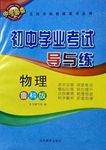
阅读理解:
David Moore taught science at the City School. He needed some expensive books , so he bought them. He left them in his car in a quiet street . Then he went to buy some other things. At six o’clock he came back to the car . One window was open-and the books were not there ! David drove home to Fry Road.
That night he wrote a letter to a newspaper. The next day he went to the police.
On Friday people read this in the newspaper:
BOOKSHave you any old books ? I buy old and new books .
Open all day on Saturday David Moore, 26 Fry Road.
David stayed at home on Saturday. His first visitor came at eight o’clock. David took him to the kitchen. At half past nine another man arrived . He had a bag under his arm.
“Mr Moore?” the man asked.
“That’s right ,”David said. “Can I help you ?”
“I’ve got some good books. You buy books , don’t you ?”
“Yes. Bring them in . I’ll have a look at them. ”
Soon the books were on the dining-table. “Come in now ,”called David, “ and bring the list.”
A policeman came into the dining-room . He read the names on the list in his hand . They were the same .
“Come with me sir ,”the policeman said to the man.
1.David had a job as ______.
[ ]
A.a bookseller B.a policeman
C.a driver D.a school teacher
2.David bought some books . They were ______ books .
[ ]
A.cheap B.old C.science D.new
3.How did the man get the books ?
[ ]
A.He bought them from David.
B.He found them in an old car.
C.He bought them from a bookseller.
D.He took them from a car.
4.The names on the list were the names of ______ .
[ ]
A.David Moore’s friends
B.the books
C.the booksellers
D.The school in the city
5.David looked at the books on the dining-table. He thought:”They’re all ______ .
[ ]
A.mine B.his C.novels D.theirs
6.How did David get his books back?
[ ]
A.A man brought them to David’s house.
B.David bought them from the visitor.
C.David got them back from a friend.
D.The police found them and gave them to David.
7.The policeman was waiting ______ .
[ ]
A.in a quiet street B.outside the bookshop
C.in the kitchen D.in the dining-room
8.David’s first visitor was a ______ .
[ ]
A.policeman
B.cook
C.good friend of his
D.person interested in old books
9.We may consider David a man of ______ .
[ ]
A.careless B.interesting C.humor D.wisdom
10.The title of the passage may be ______ .
A.Missing Books B.Books Finding
C.A Trap D.Punishment
 七星图书口算速算天天练系列答案
七星图书口算速算天天练系列答案 初中学业考试导与练系列答案
初中学业考试导与练系列答案科目:高中英语 来源: 题型:053
阅读理解
Even at the age of 89 Rene Huyghe still loves the woman with whom he spent World WarⅡ driving her from her house to safety, hiding her in his office, even sharing a bedroom with her. She was “Mona Lisa”, masterpiece of Leonardo da Vinci and a centerpiece of the Louvre. He was the chief curator(管理员)of paintings there.
Foreseeing the Nazi drive across Europe, Huyghe began planning in 1938 to hide his charges. When Germans entered Poland a year later, Huyghe’s trucks took Louvre paintings to hiding places far from Paris. “Mona Lisa” rode in a car, “always going with a curator, sometimes with me,” he recalls.
She was carried from place to place out of fear. Bombs could strike her hiding place; fire could burn her; she could end up in a German collection.
Once, as Nazi troops passed her last hiding place, Chateau de Montal, a Resistance fighter inside fired at them. Fearing retaliation(报复), Huyghe shouted to the man, “You are mad! Stop it at once!” The troops moved on and the following day razed(洗劫) entire village nearby.
“At war’s end every single work was back in the Louvre,” Huyghe says. “Mona Lisa” herself returned in a curator’s private car.
1.According to the passage, the one Rene Huyghe still loves is ______.
[ ]
A.a painting B.a German girl
C.a Resistance fighter D.a lady
2.When did the Nazi drive across Poland?
[ ]
A.Not mentioned. B.In 1938.
C.After 1938 D.Before 1938.
3.In paragraph 2, “Huyghe began planning in 1938 to hide his charges.” Means ______.
[ ]
A.Huyghe wanted to hide his money in 1938
B.Huyghe had planned to complete his tasks
C.Huyghe made a plan to hide the paintings of the Louvre in 1938
D.Huyghe hoped to take good care of his photos in 1938.
4.Which of the following is NOT TRUE according to the passage?
[ ]
A.A resistance fighter stayed together with the old man.
B.A village in which they stayed was razed by the Germans.
C.All the works were returned to the museum after the war.
D.The curator is 89 years old now.
5.Which of the following will be the best title for the passage?
[ ]
A.Nazi’s Rise and Fall
B.Rene Huyghe’s Ever Lasting Feeling with “Mona Lisa”
C.The World War and the Louvre Paintings
D.A Louvre Curator’s Wartime Companion
查看答案和解析>>
科目:高中英语 来源:高一英语Unit3 Tomorrow’s world单元质量评估(译林牛津版必修4) 题型:050
| |||||||||||||||||||||||||||||||||||||||||||||||||||||||||||
查看答案和解析>>
科目:高中英语 来源:山东省高青县第二中学2009-2010学年高二上学期期末(模块)检测英语试卷 题型:050
| |||||||||||||||||||||||||||||||||||||||||||||||||||||||||||||||||||||||||
查看答案和解析>>
科目:高中英语 来源:浙江省浙南、浙北部分学校2012届高三12月联考英语试题 题型:050
| |||||||||||||||||||||||||||||||||||||||||||||||||||||||||||||||||||||||||
查看答案和解析>>
科目:高中英语 来源:福建省师大附中2012届高三高考模拟英语试题 题型:050
| |||||||||||||||||||||||||||||||||||||||||||||||||||||||||||
查看答案和解析>>
湖北省互联网违法和不良信息举报平台 | 网上有害信息举报专区 | 电信诈骗举报专区 | 涉历史虚无主义有害信息举报专区 | 涉企侵权举报专区
违法和不良信息举报电话:027-86699610 举报邮箱:58377363@163.com